

The Top 10 Javascript MVC Frameworks Reviewed - CodeBrief. UPDATE 1/14/2012: Added Batman.js and Angular.js due to popular demand and because they looked impressive.
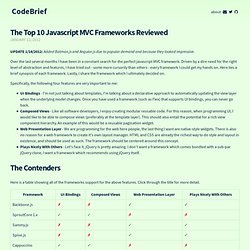
Over the last several months I have been in a constant search for the perfect javascript MVC framework. Driven by a dire need for the right level of abstraction and features, I have tried out - some more cursorily than others - every framework I could get my hands on. Here lies a brief synopsis of each framework. Plans for supporting Web Components in AngularJS and Ember.js. Plans for supporting Web Components in AngularJS and Ember.js. Single Page Apps & Realtime, a Love Story. This is the second in a series of articles on Building Realtime HTML5 Apps.
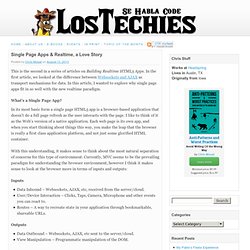
In the first article, we looked at the difference between Websockets and AJAX as transport mechanisms for data. In this article, I wanted to explore why single page apps fit in so well with the new realtime paradigm. What’s a Single Page App? In its most basic form a single page HTML5 app is a browser-based application that doesn’t do a full page refresh as the user interacts with the page.
Browser Wars: Websockets vs. AJAX. This is the first in a series of articles on Building Realtime HTML5 Apps.
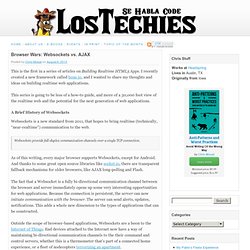
I recently created a new framework called bone.io, and I wanted to share my thoughts and ideas on building realtime web applications. This series is going to be less of a how-to guide, and more of a 30,000 foot view of the realtime web and the potential for the next generation of web applications. A Brief History of Websockets Websockets is a new standard from 2011, that hopes to bring realtime (technically, “near-realtime”) communication to the web. Websockets provide full-duplex communication channels over a single TCP connection. As of this writing, every major browser supports Websockets, except for Android.
The fact that a Websocket is a fully bi-directional communication channel between the browser and server immediately opens up some very interesting opportunities for web applications. Outside the scope of browser-based applications, Websockets are a boon to the Internet of Things. The Story of AJAX. Ember.js: Is Angular.js or Ember.js the better choice for Javascript frameworks. Node.JS: The Good Parts? A Skeptic's View. Sencha Touch / Ext JS and AngularJS: Which framework is right for your project? Written by Cliff Meyers and John Yanarella At Universal Mind, we specialize in building applications that deliver a unified customer experience across a wide gamut of screens and devices.
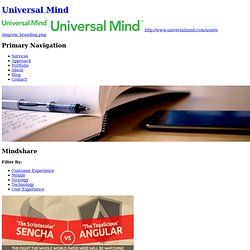
In today’s fractured and rapidly evolving technology landscape, that typically involves delivering solutions that span a variety of languages, including: Objective-C, Java, C/C++, C#, PHP, Ruby and JavaScript. Even so, the web remains a crucial platform for delivering applications that were previously thought to be solely the domain of native platform-specific SDKs. In the past few years, the core technologies that define the web— HTML, CSS and JavaScript—have undergone a renaissance. JavaScript has become the most popular language in the world and is the lingua franca of the web, not just on the client but also increasingly on the server. Single Page Applications fight - video.
Unsuck your backbone. Grunt: The Node Developer's Sidekick. Backbone.js: Basics & Beyond.
Angular: The Component Orientedness It Makes Me Happy And Why. Being a geezer programmer ain’t all bad.
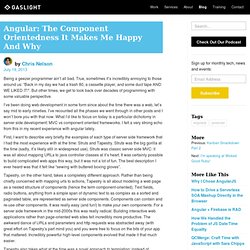
True, sometimes it’s incredibly annoying to those around us: “Back in my day we had a trash 80, a cassette player, and some duct tape AND WE LIKED IT!”. But other times, we get to look back over decades of programming with some valuable perspective. I’ve been doing web development in some form since about the time there was a web, let’s say mid to early nineties. I’ve recounted all the phases we went through in other posts and I won’t bore you with that now. What I’d like to focus on today is a particular dichotomy in server side development: MVC vs component oriented frameworks. Backbone vs Ember vs Angular vs Knockout Review. CinciJS - How I Learned Ember with Jeremy Mack. A look at how I learned Ember over the last nine months.
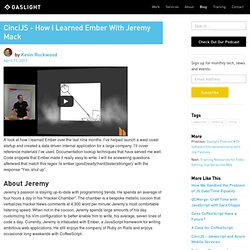
I’ve helped launch a west coast startup and created a data-driven internal application for a large company. I’ll cover reference materials I’ve used. Documentation lookup techniques that have served me well. Code snippets that Ember made it really easy to write. I will be answering questions afterward that match this regex /is ember (good|ready|hard|faster|stronger)/ with the response “Yes, shut up”. CinciJS - Lessons from Two Years of Backbone.js. CinciJS - AngularJS with Mike Ball. Kanban Smackdown Part 2. Kanban Smackdown Part 1. Client-Side IDs with Ember Data. Why Client-Generated IDs?

In most client-side frameworks (e.g. Backbone, Angular, Ember) models created in the web browser get temporary IDs (client IDs) and get their permanent ID from the server after a successful save. For client-heavy applications, generating IDs on the client can simplify interaction with the server. Consider the case where the user creates a post with several attachments. You’ll need to make sure that the post is saved and has its ID resolved before attempting to save the child models in order to preserve this relationship. It can be liberating to know the ID of a model before it is saved. Because we’re using UUIDs, you could hypothetically find any record in your application given only an ID. If you find yourself generating secret IDs for resources (think account activation URLs) you may save yourself some code by using unique IDs. About Us. AngularJS vs Ember - Evil Trout's Blog.
Recently I got together with some local developers to discuss client side MVC frameworks.
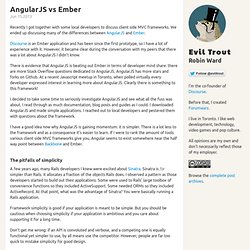
We ended up discussing many of the differences between AngularJS and Ember. Discourse is an Ember application and has been since the first prototype, so I have a lot of experience with it. However, it became clear during the conversation with my peers that there was a lot about AngularJS I didn’t know. A comparison of Angular, Backbone, CanJS and Ember - Sebastian's Blog. Selecting a JavaScript MVC framework can be hard work.
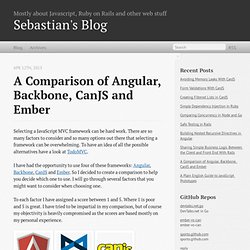
There are so many factors to consider and so many options out there that selecting a framework can be overwhelming. To have an idea of all the possible alternatives have a look at TodoMVC. Backbonejs vs Angularjs : Demystifying the myths. I love the way how each and every discussion turns into the war of the frameworks.
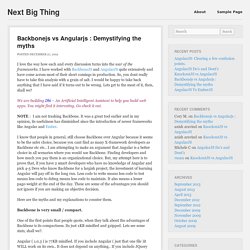
I have worked with BackboneJS and AngularJS quite extensively and have come across most of their short comings in production. So, you dont really have to take this analysis with a grain of salt. I would be happy to take back anything that I have said if it turns out to be wrong. Rich JavaScript Applications – the Seven Frameworks (Throne of JS, 2012) It’s no longer good enough to build web apps around full page loads and then “progressively enhance” them to behave more dynamically. Building apps which are fast, responsive and modern require you to completely rethink your approach. The premise was to take the seven top JavaScript frameworks/libraries for single-page and rich JavaScript applications — AngularJS, Backbone, Batman, CanJS, Ember, Meteor, Knockout, Spine — get the creators of all of them in one location, and compare the technologies head to head. The Battle of Modern Javascript Frameworks: Conclusion – Which One to Choose.
On one hand, each javascript framework has its unique advantages and it is reasonable to say that each one has its place in web development. On the other hand, these frameworks have a similar goal. The Battle of Modern Javascript Frameworks: Part V – Ember.js. Ember as it is described by its creators is ambitious and opinionated. The goal of developing ember is simple; create a web framework that will enable web apps to rival native apps. To accomplish this, ember offers an end to end solution with all the features you need to create a single page web app functioning in unison. Ember also seeks to abstract as much as possible from the programmer in order to take care of all the small decisions that programmers would otherwise have to make.
Therefore, it is also opinionated about how certain things should be done including how you name your objects, and how you organize your files. The Battle of Modern Javascript Frameworks – Part III: Backbone.js. Right now Backbone.js is probably the most popular as well as simplest of the modern javascript frameworks. As its name describes, it main goal is to give a nice MVC structure to your javascript code.
Backbones goal is to clean up your code by organizing all your data and event handlers into javascript objects. This way, events can be triggered whenever your data model changes thereby avoiding a lot of messy JQuery selectors and event bindings. The Battle of Modern Javascript Frameworks – Part I. The Battle of Modern Javascript Frameworks – Part I.